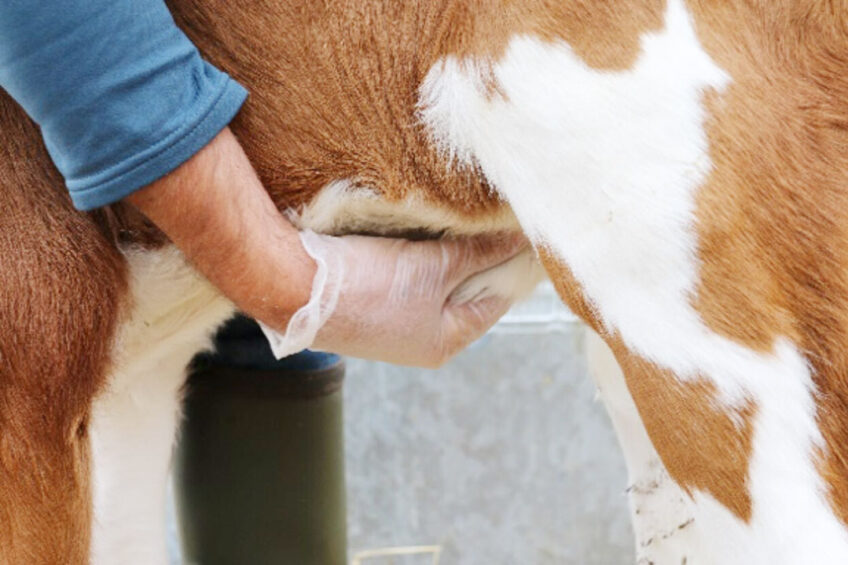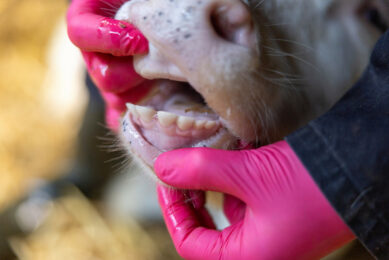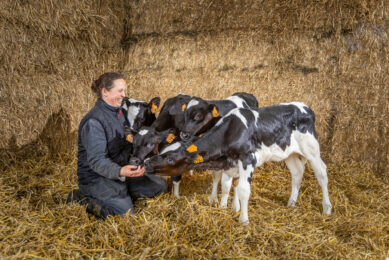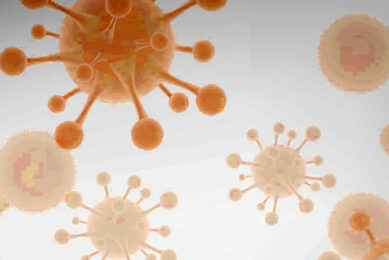New green standard for navel care of newborn calves

A navel string/umbilical cord is the highway into a calf’s bloodstream and is an open connection with the outside world after birth. Bacteria like Streptococcus sp. and E. coli can easily enter the bloodstream through the navel to cause systemic disease.
Studies have shown that 29% of illness in calves was attributed to navel associated issues. Although most calves survive these navel infections, their bodyweight gain is reduced in the first 3 months of life. In the worst cases it can result in a mortality rate around 2%.

Which treatments are out there?
Proper management of the navel right after birth can give calves a jump start. In the past, antibiotic spray was often used, but the use of antibiotics has major drawbacks such as the development of resistant pathogens and the inhalation of antibiotics by the user.
Iodine applied in a navel dip cup has also been widely used, although it can be questioned if it is the most hygienic and practical solution, since the navel cups should be (but rarely are) cleaned and refreshed between each use. Each application requires around 35 ml of iodine solution and leftovers often end up in the environment. The FDA in the US has recently moved iodine to a list 1 chemical.

This study compares the effect of a skin protection spray containing chelated copper and zinc (Intra Repiderma) with iodine on the navel condition after birth. The skin protection product is supplied as a pressurised aerosol spray, making every application fresh, no refilling is necessary, it sprays well upside down on the navel and all product is sprayed directly on the target spot (no wastage).
Comparison in the field
The study was performed at a professional dairy farm in France with 850 dairy cows. The trial began in December 2019 and lasted 3 months. In total, 200 calves were included from 7 different breeds, which were evenly divided into 2 groups: either a single application with 4% iodine (navel dip) or a single application of the skin protection spray (photo 1). Calves born in week 1 were sorted into the iodine group, calves from the next week in the skin protection spray group, and so on. Eventually, both groups consisted of 100 calves.
The independent trial was executed under full supervision of Dr C. Engel, Chêne Vert Conseil, Lécousse, and S. Clec’h, Synthèse Élevage, Pleumeleuc and presented at the GTV congress, October 2020.
Several parameters were monitored in both groups at day 0 by trained farm staff: calving ease; date/time of birth; treatment protocol; time of arrival in the pen; location of birth; calliper measurement of the navel diameter before treatment. At day 7 and 14, all navels were checked for the following parameters by the farm veterinarian (photo 2): Dry/wet navel, navel discharge yes/no, pain reaction, and colour. In case there was a pain reaction, the following health parameters were measured: calliper measurement of the navel diameter (an indication of cord drying and healing), respiratory health, diarrhoea, and rectal temperature.
The Chi2 homogeneity test is used to test the homogeneity of the different racial types in the study groups. For all quantitative variables, the mean and standard deviation (SD) have been calculated and analysed for statistically significant differences with the Mann Whitney test. Qualitative variables are analysed for statistically significant differences using the Fisher’s Exact Test. Results are considered statistically significant if p <0.05.>
Figure 1 – Schematic representation of the blood vessels from the aorta, liver, and bladder, all ending in the navel, providing a potentially open connection with the outside world.

Preventive spraying leads to 100% navel care
The number of calves, birth location and racial types are homogenous divided between the 2 groups. The charts in Figure 2 give insight into the parameters which were evaluated by the farm veterinarian as well as the total number calves with any navel issue.
Figure 2 – The percentage of calves suffering from non-dry navel, navel discharge, pain reaction or any of the previously mentioned navel issues in the Iodine or Skin protection spray treatment group in week 1 and 2.

Click here to enlarge this figure
The charts show:
- The iodine group: Measurements for all parameters deteriorated towards the 2nd week. In the 2nd week, 4 of the 100 calves (4%) had one or more navel issue.
- The skin protection spray group: Measurements for all parameters improved. In the 2nd week, none of the calves had a navel issue.
Although the results were not significant (for significance a bigger calf population would be needed), a trend can be observed in favour of Intra Repiderma application.
The importance of hygiene during treatment
Regardless of the type of treatment, animals have a significantly higher chance of not showing a painful reaction to palpation of the umbilicus at 7 days of age when treatment is performed after arriving in the calf igloo (mean treatment-arrival interval in igloo: 115 min, standard deviation: 127 min) rather than at the very moment of their arrival (p = 0.05). It is likely that the concomitant handling of calf movement and umbilicus treatment increases the risk of infection due to poor hygiene. Therefore, it seems preferable to separate the 2 tasks.
The use of iodine product per application is 35 ml, while only 10 ml Intra Repiderma is required per application. For Intra Repiderma, the whole dosage is easy to apply on the navel, so there is no waste and as it is an aerosol spray, no contamination is possible.
Authors: Daisy Roijackers R&D manager Intracare, Stévenn Clec’h Responsible Ruminant Synthèse Élevage, Dr Christian Engel Vétérinaire consultant Chêne vert conseil
Join 13,000+ subscribers
Subscribe to our newsletter to stay updated about all the need-to-know content in the dairy sector, two times a week.










